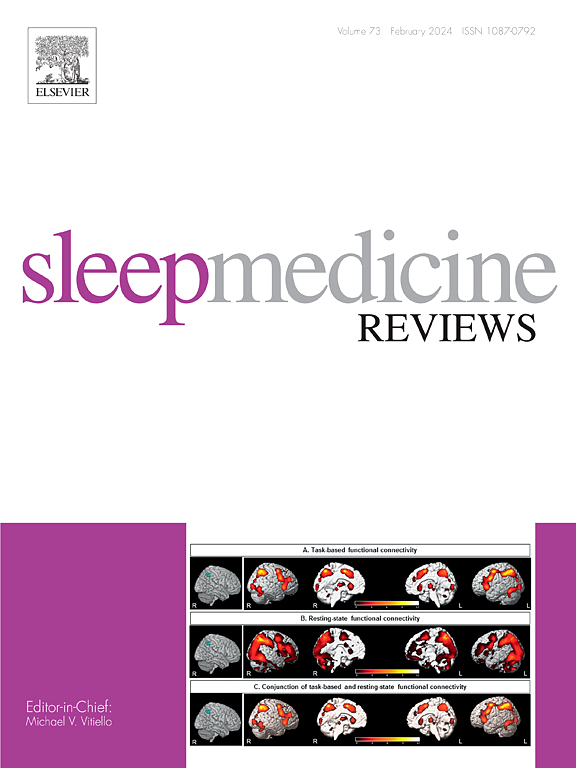气道正压治疗改善慢性高碳酸血症性呼吸衰竭患者的睡眠结构:一项系统回顾和荟萃分析
IF 9.7
1区 医学
Q1 CLINICAL NEUROLOGY
引用次数: 0
摘要
气道正压治疗(PAP)是慢性高碳酸血症性呼吸衰竭(CHRF)的标准治疗方法,包括持续气道正压(CPAP)和无创通气(NIV)治疗肥胖低通气综合征(OHS),以及无创通气治疗慢性阻塞性肺疾病(COPD)和神经肌肉疾病(NMD)。PAP对睡眠的影响反映了在纠正chrf引起的睡眠障碍和治疗本身破坏睡眠的潜力之间的平衡。鉴于睡眠在整体健康中的关键作用,人们对PAP使用对睡眠结构的影响存在相关担忧。我们对多导睡眠图参数进行了系统回顾和荟萃分析,使用随机效应模型进行定量分析。纳入40项研究(n = 1099; OHS 438例,NMD 350例,COPD 175例,CHRF 136例;58%男性,年龄56.6±8.9岁,体重指数36.5±11.3 kg/m2,动脉二氧化碳压51.8±5.0 mmHg)。PAP治疗期间,睡眠效率(+6.30[3.00,9.60]%)、慢波睡眠(+4.74[3.08,6.41]%)、快速眼动睡眠(+4.39[2.84,5.94]%)、觉醒指数(- 12.97 [-19.65,- 6.28]/h)和呼吸暂停低通气指数(- 15.13 [-22.34,- 7.92]/h)均有显著改善(估计[置信区间])。总的来说,PAP改善了CHRF患者的睡眠结构。这些变化的预后意义值得进一步研究。试验注册号prospero (CRD42023495516)本文章由计算机程序翻译,如有差异,请以英文原文为准。
Positive airway pressure therapies improve sleep architecture in patients with chronic hypercapnic respiratory failure: A systematic review and meta-analysis
Positive airway pressure therapies (PAP) are the standard of care for chronic hypercapnic respiratory failure (CHRF), and include continuous positive airway pressure (CPAP) and non-invasive ventilation (NIV) for obesity hypoventilation syndrome (OHS), and NIV for chronic obstructive pulmonary disease (COPD) and neuromuscular disease (NMD). The effects of PAP on sleep reflect a balance between correcting CHRF-induced sleep disturbances and the potential for therapy itself to disrupt sleep. Given the critical role of sleep in overall health, there are relevant concerns about the effects of PAP usage on sleep architecture. We performed a systematic review and meta-analysis of polysomnographic parameters, using a random-effects model for quantitative analyses. Forty studies were included (n = 1099; 438 OHS, 350 NMD, 175 COPD, 136 unspecified CHRF; 58 % male, age 56.6 ± 8.9 years, body mass index 36.5 ± 11.3 kg/m2, arterial carbon dioxide pressure 51.8 ± 5.0 mmHg). Significant improvements (estimate [confidence interval]) in sleep efficiency (+6.30 [3.00, 9.60]%), slow-wave sleep (+4.74 [3.08, 6.41]%), rapid-eye-movement sleep (+4.39 [2.84, 5.94]%), arousal index (−12.97 [–19.65, −6.28]/h), and apnea-hypopnea index (−15.13 [–22.34, −7.92]/h) were seen during PAP. Overall, PAP improved sleep architecture in CHRF. The prognostic significance of these changes warrants further investigation.
Trial registration
PROSPERO (CRD42023495516)
求助全文
通过发布文献求助,成功后即可免费获取论文全文。
去求助
来源期刊

Sleep Medicine Reviews
医学-临床神经学
CiteScore
20.10
自引率
3.80%
发文量
107
期刊介绍:
Sleep Medicine Reviews offers global coverage of sleep disorders, exploring their origins, diagnosis, treatment, and implications for related conditions at both individual and public health levels.
Articles comprehensively review clinical information from peer-reviewed journals across various disciplines in sleep medicine, encompassing pulmonology, psychiatry, psychology, physiology, otolaryngology, pediatrics, geriatrics, cardiology, dentistry, nursing, neurology, and general medicine.
The journal features narrative reviews, systematic reviews, and editorials addressing areas of controversy, debate, and future research within the field.
 求助内容:
求助内容: 应助结果提醒方式:
应助结果提醒方式:


